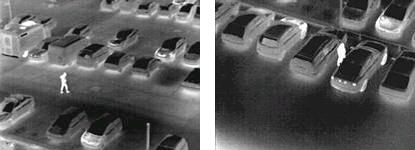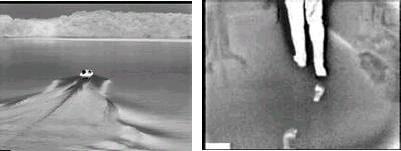
Today, the use of CCTV for security purposes is taken for granted and besides widespread application inside and outside buildings, many municipalities are trying to protect their inner cities using the same technology.
While CCTV systems have been enormously successful in improving security and identifying perpetrators the technology does have disadvantages. The normal standard CCTV camera (particularly colour) will only provide a useful image where there are reasonably high levels of illumination. This is generally true inside buildings but outside at night it can be problematic and lighting always results in shadow areas. It is possible to combine an image intensifier with the camera but this significantly increases cost, while another solution is to fit a camera with a near infrared (about 900 nm) illuminator, the latter often incorrectly being referred to as an infrared camera. The intensified camera (a technology also initially developed for the military) suffers from `blooming' in the presence of lights and ideally works using only the available moonlight or starlight.
A true infrared camera uses natural object heat to generate an image and the two most commonly used wavebands in which the earth's atmosphere is not absorbent are 3 to 5 and 8 to 12 µ. All objects that are not at absolute zero (-273°C) emit infrared radiation and even low-cost imagers can detect temperature differences as low as 0,1°C. Thermal imaging systems have been used for military applications for years, the shorter waveband being preferred for heat seeking missiles, while the longer waveband is often preferred for surveillance. This is not, however, exclusive and locally Denel has developed a range of military surveillance cameras that operate in the 3 to 5 µ region and which have been found to perform better under our atmospheric conditions and in hot and humid environments. The disadvantage of these systems for commercial applications (although they are used in police helicopters to track criminals as well as for search and rescue) is cost, as the detectors have to be cryogenically cooled and the price of an integrated detector/cooler assembly can be in the region of R200 000, without the equally expensive optics and electronics.
Just as the transistor replaced the valve and the CCD now substitutes for the vacuum-based vidicon tube, so in infrared imaging, solid state detectors are now available to replace the previously mentioned cryogenically cooled devices under certain circumstances. These solid state detectors are available in array formats (just like the CCD) so no complex scanning of the detector is required. Several differing technologies have been developed (with similar performance) but one of the most widely used is amorphous silicon uncooled microbolometers, which can be produced using existing silicon fab procedures. There are several European and North American manufacturers and as volumes grow, prices are steadily dropping. The uncooled thermal detector is available in a very compact package, similar in size to that of a CCD, and electronic requirements in terms of drive and readout are similar in complexity, the device requires no maintenance and the video output is fully compliant with existing CCTV standards.
At this point in time the uncooled device does not compete with the cooled detectors used in military applications and is only available for operation in the 8 to 12 µ band. The noise equivalent temperature difference (NETD), which is used as a measure of the efficacy of the detector, is still an order of magnitude higher, while for optimum use uncooled detectors require fast lenses (f/1) compared to the slower lenses used for the cooled detectors (typically f/3 to f/4). The difference, however, is ameliorated by the required application. For military purposes the thermal camera will be required to detect hot objects over several kilometres whereas in industrial and commercial applications (including security) the range required is often just tens of metres. Whereas military thermal imagers might have focal lengths of 300 mm or greater the typical security system would only require a focal length of about 50 mm. Even at f/1 this implies a lens diameter of just about 50 mm, reducing the cost significantly here where germanium is used as the optical material. Whereas such a lens would normally have at least two elements, new technologies are available to mould IR lenses with aspheric and diffractive surfaces. In this case a single element lens (very cost-effective in quantity production) can produce the required quality of imagery.

True thermal imagers have been used by the process industry for several years, radiometric detectors with false colour image display allowing detection of hot (or cold spots). This technology can be used to locate blockages in pipes, detect faulty electrical components that are overheating, monitor bearings and railcar wheels as well as to determine the state of health of insulators. Another area where the technology is used widely is in fire fighting where the thermal imager allows the responders to see through smoke and to rapidly find people (hot objects) overcome by smoke inhalation as well as to identify the real seat of the fire. Several prestige motor manufacturers are also offering head up displays for night driving where an infrared image is superimposed on the normal visual one. A major benefit here is that pedestrians and cyclists can easily be identified even in situations of high glare from oncoming traffic. The most recent application of this low-cost technology was when these cameras were pushed into service to screen possible travellers for symptoms (excessive body heat) of the deadly SARS.
Why then are such lenses going to find their way into security applications? If I were a clever thief I would case the building I wanted to penetrate and determine the location of the CCTV cameras. The easy way to render the latter ineffective would be to cut power to the lights providing the illumination. If I was really clever I would even make use of an easily obtained smoke grenade that would obscure the view of a normal camera. The thermal camera will, however, work equally well day or night, the long wavelength will penetrate smoke and the system is undisturbed by bright lights. The output from the thermal camera is totally CCD-compatible, but remember that we are now looking for hot objects. Software can be used to trigger an alarm when a new hot object enters the field of view. It is easy to distinguish between a cat and a human and the latter will not be able to hide behind the nearest bush as his heat signature will still be detected. The thermal camera is also an all-weather imaging device and will still provide useful imagery in foggy or rainy conditions.

Thermal imaging cameras are already being used overseas, both inside and outside buildings, an additional benefit being that fires can be rapidly detected and localised. Current developments on the detector side include the reduction of the element spacing (making the device even more compact) and the increase in the size of the array (increasing the field of view with the same focal length). More widespread adoption of the technology will result in increased volumes for both detector and lens manufacturers and will result in steadily decreasing prices as has been seen in the digital camera market. Further developments can also be expected in terms of the detector sensitivity.
In North America there are several uncooled thermal camera manufacturers and detection of a person at distances up to one kilometre are claimed, using a lens with a focal length of 100 mm. Some companies offer a colour CCD/thermal combination camera as a complete day/night solution. Thermal cameras are widely used for border surveillance as the USA has an even bigger problem than this country does, with regular incursion of Mexicans. One of the latest innovations is a very compact system with an LCD display. This can be held in one hand by police (or security personnel) leaving the dominant hand free for a baton or other weapon. This allows police and others to search for fugitives in complete darkness without betraying their position (as would be the case with a torch). Not only have fugitives been discovered in such hiding places as rubbish bins, the technology also allows identification of recently disturbed soil and can find evidence, such as shell casings or tossed vials, in complete darkness. The thermal imager also really comes into its own in marine applications where fugitives or people needing rescue stand out in clear detail against the cold water. Many of these cameras highlight hot objects through superposition of a colour, usually red, on the display.

Although there is a current paranoia about terrorism in North America it could well be that no one is immune to this growing threat, even if it is only relatively peaceful incursions by the Green movement. Expect to see more use of thermal cameras in the local scenario particularly where large perimeters of sensitive installations (eg, power stations, oil refineries, harbours, container depots and correctional facilities) have to be protected. One can only hope that the government itself adopts the technology to try and provide assistance to the defence force personnel trying to reduce illegal immigration. The latter is the ideal scenario for the technology as no illumination is required and distances are vast.

© Technews Publishing (Pty) Ltd. | All Rights Reserved.